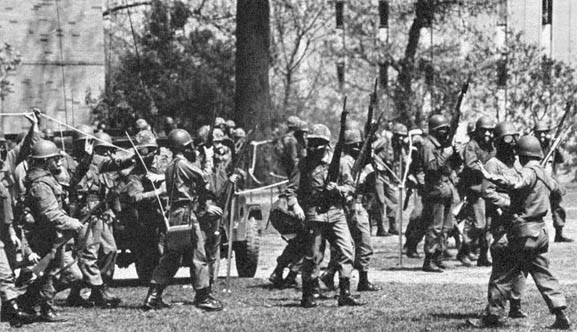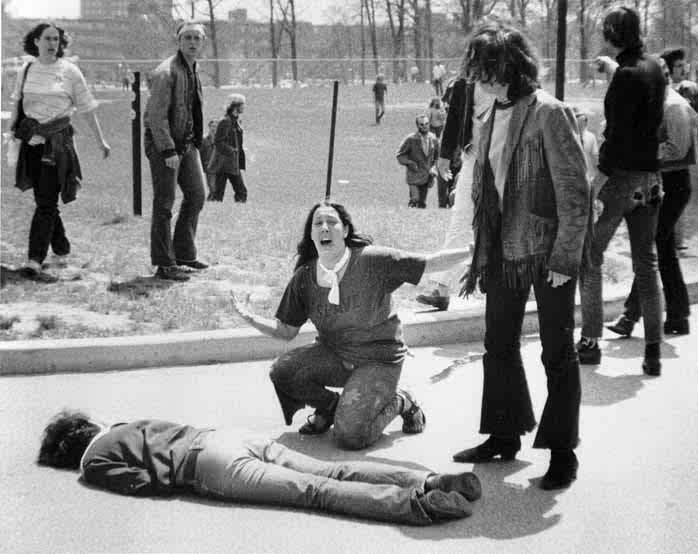Last night we went with his younger brother, we thought we go with the elder this evening, Keith Jarrett

A wonderful song, a duo with the great Norwegian saxophonist, Jan Garbarek
Enjoy!
Keith Jarrett & Jan Garbarek "My Song"









The Kent State shootings – also known as the May 4 massacre or Kent State massacre – [2][3][4] occurred at Kent State University in the city of Kent, Ohio, and involved the shooting of unarmed college students by members of the Ohio National Guard on Monday, May 4, 1970. The guardsmen fired 67 rounds over a period of 13 seconds, killing four students and wounding nine others, one of whom suffered permanent paralysis.[5]
Some of the students who were shot had been protesting against the American invasion of Cambodia, which President Richard Nixon announced in a television address on April 30. Other students who were shot had been walking nearby or observing the protest from a distance.[6][7]

The Ohio National Guardsmen who fired on students and antiwar protesters at Kent State University on May 4, 1970 were given an order to prepare to shoot, according to a new analysis of a 40-year-old audio tape of the event.
"Guard!" says a male voice on the recording, which two forensic audio experts enhanced and evaluated at the request of The Plain Dealer. Several seconds pass. Then, "All right, prepare to fire!"
"Get down!" someone shouts urgently, presumably in the crowd. Finally, "Guard! . . . " followed two seconds later by a long, booming volley of gunshots. The entire spoken sequence lasts 17 seconds.

The previously undetected command could begin to explain the central mystery of the Kent State tragedy - why 28 Guardsmen pivoted in unison atop Blanket Hill, raised their rifles and pistols and fired 67 times, killing four students and wounding nine others in an act that galvanized sentiment against the Vietnam War.
The order indicates that the gunshots were not spontaneous, or in response to sniper fire, as some have suggested over the years.

The country eventually disengaged from Vietnam. But that was only one skirmish in our ongoing tribal struggle --- it still rages today. History can now record what really happened that day at Kent State. But I think we can assume from the Nixonland excerpt that whether or not the Guardsmen shot under orders was never really the issue anyway.(Susie Madrak, over on Crooks and Liars, has a post with video, and audio)
The funny thing is that the same Real Americans who believed the protesters deserved it would join the tea parties today and complain mightily about government overreach. In fact, many of them probably have.

In Pittsburgh, Doris Krause has been waiting 40 years to find out who killed her daughter Allison, and why. Now 84 and widowed, she said Friday the presence of the prepare-to-fire order doesn't surprise her.
"It had to be," she said. "There's no other way they could have turned in unison without a command. There's no other way they could fire at the same time."
She is frustrated, though, that the recording can't identify the person who gave the order. "I wish there was better proof," Krause said. "We have to find a man with enough courage to admit what happened.
"I'm an old lady," she said, "and before I leave this earth, I'd like to find out who said what is on that tape."

In Iron Man 2, billionaire industrialist Tony Stark (Robert Downey Jr.) risks billion-dollar pieces of equipment to impress guests at a birthday party -- a big mistake for a defense contractor. After all, Stark's reckless debauchery provides the perfect pretext for the U.S. government to take away his Iron Man suit. Explosions, tattoos, and Scarlett Johansson notwithstanding, the disputes between Tony Stark and his antagonists revolve around ownership of the rights to the Iron Man technology. Iron Man 2 is the most expensive movie ever made about an intellectual property dispute.
[snip]
In the United States, inventors are supposed to profit from their creations, as emphasized in the original comics. But Iron Man 2 takes a different tack. While trying to fend off Vanko, Stark is pressured by the U.S. government to give up the secrets of the Iron Man suit. After Stark refuses a senator's demand that he relinquish his body-armor technology, the government forcibly takes it from him, only to turn it over to a competitor that then uses the technology to fulfill its own defense contract. Consciously or no, this echoes the real world; the United States government can take such actions with almost total legal impunity.
These inventors theoretically have their own superpower at their disposal: the Fifth Amendment's "Takings Clause," which requires compensation for government appropriation. But it has one weakness: the military and state secrets privilege, which has been invoked with increasing frequency in the past 25 years. Perhaps most notably, it has been used to prevent suspected terrorists from obtaining access to incriminating information. Less well known is the role it has played in suppressing intellectual-property owners' attempts to recover compensation for government use of their innovations.
[snip]
Stark didn't need a monetary incentive to develop his technology. And presumably Stark, either individually or through his company, retained sufficient political pull to obtain compensation for that stolen technology without having to rely on the Takings Clause. Of course, he's just a fictional comic book hero. But as audiences watch Senate efforts to persuade Tony Stark to relinquish Iron Man technology to the U.S. Government, they should keep in mind that Stark's greatest power might not be his full-body armor but instead his company's political connections.




Q - If I order a soft drink at a fast-food restaurant, I can drink it with a thin straw or a wide straw, with little difficulty either way. When it comes to a milkshake though, I can’t get anything at all through the narrow straw. Why?There is more detail Dr. Knowledge provides the benighted milkshake drinker, so check that out.
A - The first thing to notice about the milkshake is that it’s viscous, which is the scientific way of saying that it’s sticky. Water is somewhat viscous, too, but much less so.
[snip]
If you can just manage to suck up a milkshake through the wide straw, however, you would need 16 times the suction to get it up the narrower one at the same rate.


Ms. Horne was stuffed into one “all-star” musical after another — “Thousands Cheer” (1943), “Broadway Rhythm” (1944), “Two Girls and a Sailor” (1944), “Ziegfeld Follies” (1946), “Words and Music” (1948) — to sing a song or two that could easily be snipped from the movie when it played in the South, where the idea of an African-American performer in anything but a subservient role in a movie with an otherwise all-white cast was unthinkable.
[snip]
Touring Army camps for the U.S.O., Ms. Horne was outspoken in her criticism of the way black soldiers were treated. “So the U.S.O. got mad,” she recalled. “And they said, ‘You’re not going to be allowed to go anyplace anymore under our auspices.’ So from then on I was labeled a bad little Red girl.”
Ms. Horne later claimed that for this and other reasons, including her friendship with leftists like Paul Robeson and W.E.B. DuBois, she was blacklisted and “unable to do films or television for the next seven years” after her tenure with MGM ended in 1950.
[snip]
Ms. Horne’s voice was not particularly powerful, but it was extremely expressive. She reached her listeners emotionally by acting as well as singing the romantic standards like “The Man I Love” and “Moon River” that dominated her repertory. The person she always credited as her main influence was not another singer but a pianist and composer, Duke Ellington’s longtime associate Billy Strayhorn.
“I wasn’t born a singer,” she told Strayhorn’s biographer, David Hajdu. “I had to learn a lot. Billy rehearsed me. He stretched me vocally.” Strayhorn occasionally worked as her accompanist and, she said, “taught me the basics of music, because I didn’t know anything.”
[snip]
Looking back at the age of 80, Ms. Horne said: “My identity is very clear to me now. I am a black woman. I’m free. I no longer have to be a ‘credit.’ I don’t have to be a symbol to anybody; I don’t have to be a first to anybody. I don’t have to be an imitation of a white woman that Hollywood sort of hoped I’d become. I’m me, and I’m like nobody else.”

I know why there's no sun up in the sky and that's because the world has lost the irreplaceable Lena Horne at the age of 92. The actress/singer who helped to break down racial barriers by becoming the first African-American performer to receive a major Hollywood studio contract passed away Sunday night in a Manhattan hospital.
[snip]
The bulk of her career was spent taking that sultry voice to concert halls or appearing as herself in other venues such as That's Entertainment III and sitcoms such as A Different World, The Cosby Show and a particularly memorable Sanford & Son, where Fred tricked her into coming to his house claiming that Lamont was his young, terminally ill child.
I know the exact moment I saw Lena Horne for the first time. I was 11, and she made a guest appearance on "The Cosby Show," as herself, in an episode where Claire (Phylicia Rashad) took Cliff (Bill Cosby) to see her perform for his birthday. I remember thinking how beautiful and glamorous she was, and falling utterly in love with her voice, which has remained to this day one of my absolute favorites—totally recognizable, totally unmistakable, totally butter.



It’s Kagan
9750 Words on Elena Kagan ...More than you ever wanted to know
Where We Go From Here ...Process and substance in a Kagan nomination



Mother's Day is an annual holiday that recognizes mothers, motherhood and maternal bonds in general, as well the positive contributions that they make to society. In the United States, it is celebrated on the second Sunday in May.
[snip]
In its present form, Mother's Day was established by Anna Marie Jarvis, following the death of her mother Ann Jarvis on May 9, 1905, with the help of a Philadelphia merchant called John Wanamaker.[2] A small service was held in May 12, 1907 in the Andrew's Methodist Episcopal Church in Grafton, West Virginia, where Anna's mother had been teaching Sunday school.[2] But the first "official" service was in May 10, 1908 in the same church, accompanied by a larger ceremony in the Wanamaker Auditorium in the Wanamaker's store on Philadelphia.[2] She then campaigned to establish Mother's Day as a U.S. national holiday, and later as an international holiday.[1][2]
The holiday was declared officially by the state of West Virginia in 1910, and the rest of states followed quickly.[2] On May 8, 1914, the U.S. Congress passed a law designating the second Sunday in May as Mother's Day and requesting a proclamation. On May 9, 1914, President Woodrow Wilson issued a proclamation, declaring the first national Mother's Day,[9][10] as a day for American citizens to show the flag in honor of those mothers whose sons had died in war.[9]
In 1934, U.S. President Franklin D. Roosevelt approved a stamp commemorating the holiday.[11]
"Sweet Mother" is a highlife song by the Nigeria/Cameroonian singer Prince Nico Mbarga and his band Rocafil Jazz. Released in 1976, it remains one of the most popular songs in Africa.


"More than anything else, he wanted to be remembered." That's how Nathaniel ("Mayflower") Philbrick sizes up George Armstrong Custer toward the end of "The Last Stand: Custer, Sitting Bull and the Battle of the Little Bighorn,"and no one will dispute that America's ultimate glory hound got his wish. Too bad the victorious Lakota and Cheyenne weren't feeling respectful after wiping out his command in what's now Montana on June 25, 1876. They not only punctured the dead Custer's eardrums because he "wouldn't listen," but -- in a detail long suppressed by decorum -- jammed an arrow up the corpse's penis.Yikes!
But the larger enterprises the other two symbolize are less morally iffy, which is why Custer's main contribution to winning-of-the-West triumphalism was providing it with a martyr. For 19th-century audiences, Sitting Bull's morose participation in the reenactments that climaxed Buffalo Bill's hugely popular Wild West show in the 1880s must have seemed like the equivalent of the real Pontius Pilate performing in a passion play.
Today, Custer has long since become an embarrassment to educated white Americans. But the effort we've put into debunking him amounts to admitting we're stuck with him. From the Goldilocks hairdo he'd actually rid himself of before Little Bighorn to the final, almost certainly inaccurate, tableau of The Last White Man Standing as the "hostiles" close in, he's the horse's ass we rode in on.
[snip]
By 1876, Custer was a renowned enough Indian fighter to have published a bestselling autobiography two years earlier: "My Life on The Plains," renamed "My Lie on The Plains" by one skeptic who'd served under him. But after the laurels he'd won as the Civil War's youngest and most dashing model of a modern major general, his reduced peacetime rank and constricted room for initiative left him chafing. Mistrusted by his superiors, he had even more fractious relations with two of his subordinates: Major Marcus Reno and Captain Frederick Benteen, who didn't much like each other either. This was fateful, since Reno and Benteen were in charge of the Seventh Cavalry's other two columns once Custer's contingent rode off.

Custer's plan was apparently to duplicate his success eight years earlier against Black Kettle's Cheyenne band on the Washita, one of those engagements white people called a battle and Indians called a massacre. Splitting his command then as now, he'd destroyed the Indians' village -- populated mainly by women and children -- and devastated their pony herd, then gotten away before their warriors could hit him back.

Experts may find more to quarrel with here than I did. But even if Philbrick has everything right, that doesn't make "The Last Stand" the "definitive" book on the Little Bighorn, any more than Connell's was. There clearly ain't no such animal, and never will be. What may be most to this one's credit is a humanity that can make even inveterate Custer-haters pity the men who got stuck following him, as did at least one Sioux warrior at the time. "I felt really sorry for them, they looked so frightened," Standing Bear later told his son. "Many of them lay on the ground, with their blue eyes open, waiting to be killed."

